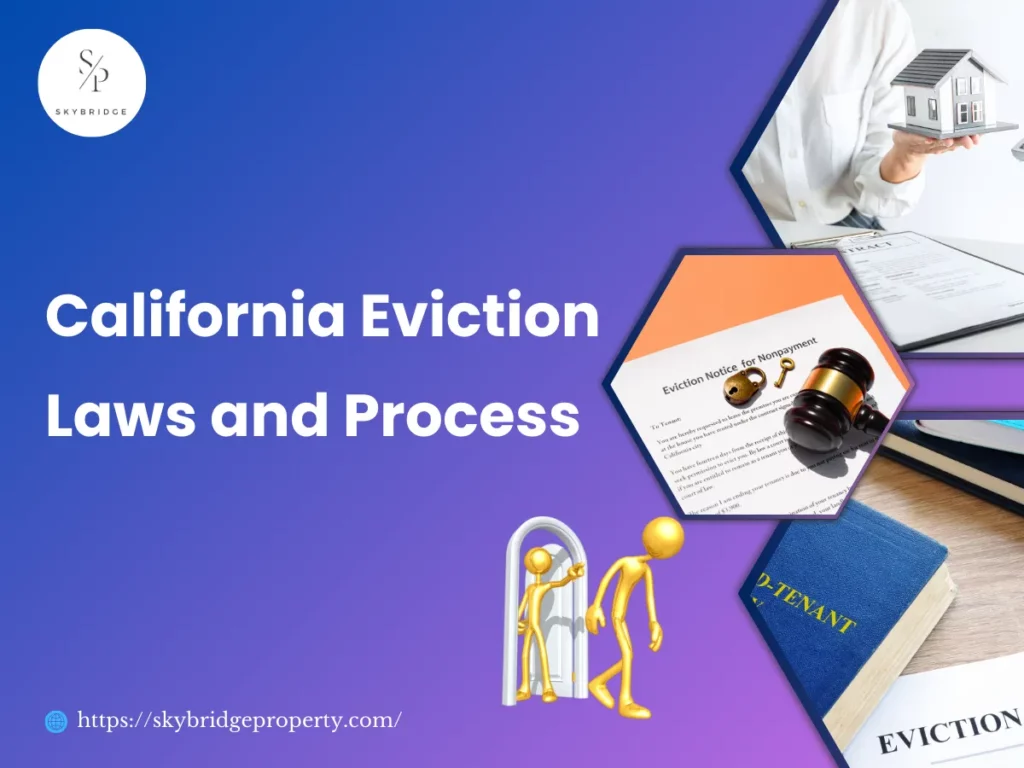Eviction is a legal process that allows a landlord to remove a tenant from a rental property. In California, eviction laws are strict and detailed, ensuring that both landlords and tenants follow proper legal procedures. Whether it’s due to unpaid rent, lease violations, or other reasons, landlords cannot simply force a tenant out; they must go through a step-by-step legal process.
California has strong tenant protections, which means that not all evictions are allowed. In some cases, landlords must provide a valid reason, known as just cause, before they can remove a tenant. Even in situations where a landlord has a legal right to evict, the process involves official notices, court filings, and possible hearings before a judge.
This guide will cover everything you need to know about California eviction laws, including legal grounds for eviction, the step-by-step eviction process, eviction costs and how recent laws impact both landlords and renters.
TL;DR
California Eviction Process:
- Step 1: Notice
- Step 2: Filing an Unlawful Detainer Lawsuit
- Step 3: The Landlord Serves the Unlawful Detainer Paperwork on the Tenant
- Step 4: Trial or Hearing
- Step 5: Eviction Judgment
- Step 6: Removing the Tenant
When Landlords Can Evict Tenants in California?
Landlords in California can only evict tenants for specific legal reasons. These fall into two main categories: at-fault evictions and no-fault evictions.
At-fault evictions occur when a tenant violates the lease agreement. Common reasons include non-payment of rent, property damage, illegal activity, or refusing to leave after the lease ends. In these cases, the landlord must provide proper notice before starting the eviction process.
No-fault evictions happen when the tenant has done nothing wrong, but the landlord needs to reclaim the property. This may be due to owner move-in, major renovations, or removing the unit from the rental market under the Ellis Act. For these evictions, landlords must often provide relocation assistance to the tenant.
Terminating a California Tenancy for Cause
A landlord can terminate a tenancy for cause when a tenant has violated the rental agreement or engaged in behavior that justifies eviction. In such cases, the landlord must follow legal procedures, including giving proper notice and allowing the tenant a chance to correct the issue if applicable.
Reasons for At-Cause Eviction
An at-cause eviction happens when the tenant is responsible for violating the lease. Common reasons include:
- Non-payment of rent – If a tenant fails to pay rent on time, the landlord can serve a 3-Day Notice to Pay Rent or Quit.
- Lease violations – Unauthorized subletting, keeping pets in a no-pet unit, or exceeding occupancy limits can lead to eviction.
- Property damage – If a tenant causes significant damage beyond normal wear and tear, the landlord can issue an eviction notice.
- Illegal activities – If a tenant engages in drug-related offenses, violence, or any criminal activity on the premises, the landlord has grounds for immediate eviction.
- Refusing to vacate after lease expiration – If a tenant remains on the property without renewing the lease or switching to a month-to-month agreement, the landlord can proceed with an eviction.
Requirements for Good Cause Eviction
Under California’s just cause eviction laws, landlords cannot remove a tenant without good cause, especially for tenants who have lived in the unit for 12 months or longer. Good cause requirements include:
- Proper notice – The landlord must provide a written eviction notice specifying the violation and allowing the tenant a chance to correct it if possible.
- Legal process – If the tenant does not comply, the landlord must file an unlawful detainer lawsuit in court rather than taking matters into their own hands.
- Fair treatment – The eviction cannot be based on retaliation, discrimination, or harassment, as these are illegal under California law.
- Relocation assistance – In some cases, especially for no-fault evictions, the landlord must provide financial assistance to help the tenant relocate.
Terminating a California Tenancy for No Cause
In California, landlords cannot evict tenants without cause unless specific conditions are met. For tenants who have lived in a rental unit for less than 12 months, landlords may terminate the tenancy without giving a reason, provided they follow proper notice requirements. However, for tenants residing 12 months or longer, just cause protections apply under the Tenant Protection Act of 2019 (AB 1482). In such cases, the landlord must provide a legally valid reason for eviction, even if the tenant has done nothing wrong.
Reasons for No Cause Eviction
A no-cause eviction occurs when the landlord wants to reclaim the property for reasons unrelated to tenant misconduct. Common reasons include:
- Owner move-in – The landlord or an immediate family member intends to occupy the rental unit as their primary residence.
- Substantial renovations – If the unit requires major repairs that make it uninhabitable, the landlord can evict the tenant, provided the work is substantial (not just cosmetic improvements).
- Ellis Act eviction – The landlord is removing the property from the rental market entirely, such as converting it into a personal residence or another use.
- Compliance with government orders – If a city or state agency requires the building to be vacated due to code violations or unsafe conditions, the landlord may legally evict tenants.
Requirements for No Cause Eviction
Even when a tenant is evicted for no cause, California law requires landlords to meet strict legal requirements:
- Proper notice periods –
- 30-day notice for tenants who have lived in the unit for less than a year.
- 60-day notice for tenants who have lived in the unit for 12 months or more.
- Relocation assistance – For no-fault evictions, landlords must provide either one month’s rent in relocation assistance or waive the tenant’s final month’s rent.
- No retaliatory or discriminatory motives – The eviction cannot be based on discrimination, retaliation, or tenant complaints about habitability issues.
- Documented intent – Landlords must provide written justification for evictions based on owner move-in, renovations, or the Ellis Act and follow through on their stated intent to avoid legal consequences.
California Eviction Laws and Process
The California eviction process follows a legal framework to ensure fairness for both landlords and tenants. Landlords must follow specific steps to lawfully remove a tenant, and failing to do so can lead to legal penalties. Below is a detailed step-by-step breakdown of the eviction process in California.
Step 1: Notice
The eviction process begins with the landlord providing the tenant with a written notice. The type of notice depends on the reason for eviction:
- 3-Day Notice to Pay Rent or Quit – Given when a tenant fails to pay rent on time. The tenant has three days to pay or vacate the property.
- 3-Day Notice to Cure or Quit – Used when a tenant violates the lease, such as having unauthorized pets or subletting. The tenant has three days to correct the issue or leave.
- 3-Day Unconditional Quit Notice – This notice requires the tenant to vacate immediately for severe violations, such as criminal activity, major property damage, or threats to others.
- 30-Day or 60-Day Notice to Vacate – Used for no-fault evictions when the landlord needs the property for owner move-in, major renovations, or Ellis Act evictions.
- 30-day notice – For tenants who have lived in the unit less than a year.
- 60-day notice – For tenants residing more than a year.
If the tenant fails to comply, the landlord can proceed to court.
Step 2: Filing an Unlawful Detainer Lawsuit
If the tenant does not fix the violation or move out after receiving a proper notice, the landlord must file an unlawful detainer lawsuit in the Superior Court of California.
- The landlord submits a Complaint (Unlawful Detainer) and a Civil Case Cover Sheet to officially start the eviction case.
- A court filing fee is required, which typically ranges from $240 to $450, depending on the county.
- The court assigns a case number and schedules further proceedings.
Once filed, the landlord must notify the tenant of the lawsuit
Step 3: The Landlord Serves the Unlawful Detainer Paperwork on the Tenant
The tenant must be legally notified of the lawsuit. This is done through proper service of process, which can be carried out in one of the following ways:
- Personal Service – A process server or sheriff hands the eviction papers directly to the tenant.
- Substituted Service – If the tenant is unavailable, the paperwork can be left with a responsible adult at the rental unit and mailed to the tenant.
- Posting and Mailing (Only if Court-Approved) – If the tenant cannot be reached, the court may allow the landlord to post the notice on the rental property and mail a copy.
The tenant then has five days to file a written response with the court.
Step 4: Trial or Hearing
If the tenant contests the eviction, a court hearing will be scheduled, usually within 20 days. At this stage:
- Both the landlord and tenant present evidence before a judge.
- The tenant may argue habitability defenses, discrimination, or retaliatory eviction as reasons why they should not be evicted.
- The judge reviews the case and makes a final decision.
If the tenant does not respond within five days, the landlord can request a default judgment, which allows the eviction to proceed without a trial.
Step 5: Eviction Judgment
If the judge rules in favor of the landlord, the court issues a Judgment of Possession, giving the landlord legal right to reclaim the property.
- The court also issues a Writ of Possession, which allows the Sheriff’s Department to enforce the eviction.
- The landlord cannot forcibly remove the tenant themselves—only law enforcement can carry out the eviction.
Step 6: Removing the Tenant
Once the Writ of Possession is issued, the sheriff serves the tenant a 5-day notice to vacate.
- If the tenant fails to leave, the sheriff physically removes them from the property.
- The landlord must change the locks only after the sheriff completes the eviction.
- If the tenant leaves belongings behind, the landlord must store them for at least 15 days and follow proper disposal procedures.
At this point, the eviction process is complete, and the landlord regains possession of the rental unit.
Recent Legal Updates
California’s eviction laws continue to evolve with new legislation aimed at strengthening tenant protections and ensuring fair treatment in eviction cases. Recent laws, including Senate Bill 567 (2024) and Assembly Bill 2347 (2025), introduce stricter regulations for landlords and expand tenants’ rights. These laws impact just cause evictions, rent control, and relocation assistance requirements.
Additionally, emergency tenant protections have been enacted in response to economic challenges, natural disasters, and public health crises. These protections temporarily pause evictions under certain conditions, giving tenants more time to secure stable housing.
Understanding these legal changes is crucial for both landlords and tenants to stay compliant and avoid legal disputes. In the next section, we’ll dive into the details of these new eviction rules and how they affect the California eviction process.
Assembly Bill 2347 (2025)
Assembly Bill 2347 (AB 2347), set to take effect from Jan 1, 2025, introduces stronger tenant protections by placing new restrictions on no-fault evictions and increasing financial assistance for displaced renters. The law aims to prevent landlords from using loopholes to remove tenants unfairly while ensuring that those evicted for legitimate reasons receive adequate relocation support.
Key Provisions of Assembly Bill 2347
- Stronger Just Cause Protections – Expands the requirements for no-fault evictions, making it harder for landlords to remove long-term tenants without a valid reason.
- Increased Relocation Assistance – Raises the required financial compensation for tenants facing no-fault evictions, ensuring they have more time and resources to secure new housing.
- Limitations on Owner Move-In Evictions – Requires landlords to prove intent to occupy the unit for a minimum period of time to prevent fraudulent evictions.
- Tenant Notification Requirements – Mandates landlords to provide detailed written explanations when serving eviction notices to prevent misuse of eviction laws.
Senate Bill 567 (2024)
Senate Bill 567 (SB 567), which took effect in 2024, strengthens tenant protections under California’s just cause eviction laws. The law addresses landlord abuses of no-fault evictions, ensuring that tenants are not unfairly displaced. It also increases penalties for landlords who wrongfully evict tenants by falsely claiming they need the property for personal use.
Key Provisions of SB 567
- Stricter Owner Move-In Rules – Landlords must prove intent to occupy the unit for at least 12 months and provide proper documentation to avoid fraudulent evictions.
- Higher Penalties for Wrongful Evictions – If a landlord falsely evicts a tenant under no-fault grounds, they may face fines and tenant compensation requirements.
- Increased Relocation Assistance – Tenants forced to move under no-fault evictions are entitled to relocation payments, helping them transition to new housing.
- Extended Protections for Vulnerable Tenants – Seniors, disabled tenants, and low-income renters receive additional time and legal support before eviction proceedings can move forward.
Emergency Tenant Protections
California has implemented emergency tenant protections in response to economic downturns, natural disasters, and public health crises. These temporary laws pause evictions under specific conditions, ensuring that tenants are not displaced due to circumstances beyond their control. These protections aim to provide housing stability during difficult times while balancing landlords’ rights.
Key Aspects of Emergency Tenant Protections
- Eviction Moratoriums – During declared emergencies, state and local governments can temporarily ban evictions for non-payment of rent due to financial hardship.
- Extended Notice Periods – Landlords may be required to give tenants longer notice periods before filing an eviction case.
- Rental Assistance Programs – Some emergency protections include financial aid for tenants struggling to pay rent, preventing eviction due to unpaid rent.
- Ban on Late Fees and Rent Increases – In some cases, landlords cannot impose late fees or raise rent during a state of emergency.
- Special Protections for Vulnerable Tenants – Seniors, disabled individuals, and low-income renters may receive additional time before eviction proceedings can continue.
Rent Control and Just Cause Ordinances
California has statewide rent control and just cause eviction protections under the Tenant Protection Act of 2019 (AB 1482). Additionally, many cities have local ordinances that impose stricter rules on rent increases and evictions to further protect tenants. These laws ensure that landlords cannot remove tenants without a valid reason and limit how much rent can be raised each year.
Rent Control in California
Costs Associated with a Legal California Eviction Process
The eviction process in California can be expensive, with costs adding up quickly for landlords. From legal fees to lost rental income, landlords must prepare for several financial obligations. Below is a breakdown of the key expenses involved in an eviction.
Filing Fees
To begin an unlawful detainer lawsuit, landlords must pay court filing fees, which vary by county:
- $240 to $450 for most cases, depending on the amount of back rent owed.
- Additional fees may apply if the case requires multiple hearings or appeals.
Legal Representation
While landlords can represent themselves, hiring an eviction lawyer is often necessary, especially if the tenant contests the eviction.
- Attorneys typically charge $500 to $5,000, depending on the case’s complexity.
- Costs increase if the case involves court trials, tenant appeals, or counterclaims.
Process Server Fees
The eviction paperwork must be legally served to the tenant, which incurs additional costs:
- Professional process servers charge $50 to $150 per service attempt.
- If the tenant avoids service, multiple attempts may be necessary, increasing the total cost.
Lost Rent
During the eviction process, the landlord may lose one to three months of rental income while waiting for the case to resolve.
- If the tenant is not paying rent, the financial impact can be significant.
- Even after an eviction, landlords often face additional delays in finding a new tenant.
Property Damage
Some tenants may cause damage before vacating the rental unit. Landlords often face expenses related to:
- Repairing broken appliances, walls, and flooring.
- Cleaning and repainting the unit to make it ready for the next tenant.
- Costs vary widely but can range from a few hundred to several thousand dollars.
Storage and Disposal of Tenant Belongings
If a tenant abandons belongings after an eviction, the landlord must follow legal procedures for storage and disposal:
- Items must be stored for at least 15 days, during which the tenant can reclaim them.
- If the items remain unclaimed, the landlord can sell or dispose of them.
- Storage and disposal costs can range from $200 to $1,000, depending on the volume of belongings.
Other Costs:
- Sheriff’s eviction fee – Typically $125 to $150 for enforcing the Writ of Possession.
- Relocation assistance – For no-fault evictions, landlords must pay one month’s rent to displaced tenants.
- Vacancy costs – The time between eviction and securing a new tenant leads to additional income loss.
Tips for Managing Eviction Costs
Evictions can be expensive and time-consuming, but landlords can take proactive steps to reduce costs and financial risks. Below are strategies to minimize eviction expenses and handle tenant issues more effectively.
1. Screen Tenants Thoroughly: A careful screening process reduces the risk of renting to problematic tenants who may fail to pay rent or violate lease terms. The best way to avoid costly evictions is to rent to reliable tenants. Conduct a detailed tenant screening that includes:
- Credit checks to assess financial responsibility.
- Rental history to see past evictions or disputes.
- Employment verification to ensure a stable income.
- Eviction reports to identify tenants with prior legal issues.
2. Use Ironclad Lease Agreements: A well-drafted lease agreement protects landlords by clearly outlining:
- Rent payment terms and late fees.
- Rules for subletting, property use, and occupancy limits.
- Consequences for lease violations, including potential eviction.
- Ensure that the lease complies with California eviction laws to avoid legal disputes.
3. Maintain Open Communication: Many eviction cases stem from misunderstandings or financial hardship. A cooperative approach may prevent an expensive and lengthy eviction process. Before filing an eviction, try to:
- Discuss payment plans with tenants who are struggling financially.
- Offer mediation to resolve lease violations amicably.
- Send formal warnings before serving an eviction notice.
4. Serve Proper Notices Early: If eviction becomes necessary, act quickly and follow legal steps correctly. Delays or mistakes in the eviction notice process can result in case dismissal and additional costs.:
- Serve the appropriate eviction notice based on the situation (e.g., 3-Day Notice to Pay Rent or Quit).
- Ensure the notice is properly documented and delivered to avoid legal delays.
- Keep copies of all communications and notices for court proceedings.
5. Work with a Property Manager
Hiring a property manager can help landlords. Though property management comes at a cost, it can prevent major financial losses from problem tenants:
- Handle rent collection and tenant communication.
- Enforce lease agreements and address violations early.
- Reduce eviction risks by screening tenants effectively.
6. Consider a Cash-for-Keys Agreement: Instead of going through costly eviction proceedings, landlords can offer a cash-for-keys deal. While this involves an upfront payment, it can be cheaper than a full eviction that takes months to complete.:
- Offer the tenant money (typically $500 to $2,000) to vacate voluntarily.
- Have the tenant sign a written agreement confirming they will leave by a set date.
7. Budget for Eviction-Related Expenses
Even with preventative measures, evictions can still happen. Landlords should:
- Set aside at least two months’ worth of rent as an eviction fund.
- Factor in legal fees, vacancy costs, and repairs when calculating profitability.
- Stay informed about California eviction rules to avoid costly legal mistakes.
Documentation and Evidence to Evict Tenant
Proper documentation and evidence are crucial in an eviction case. If a tenant disputes the eviction, the landlord must provide proof that they followed California eviction laws correctly. Below are the key documents and records landlords should keep to support their case.
1. Signed Lease Agreement
A valid lease agreement outlines:
- Rent payment terms and due dates.
- Tenant responsibilities (e.g., property maintenance, no subletting).
- Eviction clauses for lease violations.
This document serves as the foundation for proving that the tenant broke the lease terms.
2. Rent Payment Records
To evict for non-payment of rent, landlords need:
- Bank statements or online payment records showing missed payments.
- A rent ledger tracking all payments, late fees, and balances.
- Copies of late rent notices sent to the tenant.
These records confirm that the tenant failed to pay rent despite reminders.
3. Written Notices Served to Tenant
Before filing an eviction case, landlords must provide proper notice. Key notices include:
- 3-Day Notice to Pay Rent or Quit (for unpaid rent).
- 3-Day Notice to Cure or Quit (for lease violations).
- 30-Day or 60-Day Notice to Vacate (for no-fault evictions).
Landlords should keep copies of:
- The notice itself.
- Proof of service (e.g., signed delivery confirmation, affidavit from a process server).
If notices are not properly documented, the court may dismiss the eviction case.
4. Tenant Communication Records
All emails, text messages, and letters exchanged with the tenant should be saved, especially if they:
- Acknowledge unpaid rent or lease violations.
- Refuse to comply with requests to fix an issue.
- Admit to receiving eviction notices.
This helps prove that the tenant was aware of the violations and had a chance to resolve them.
5. Property Inspection Reports and Photos
If the eviction is due to property damage or lease violations, landlords need:
- Before-and-after photos or videos showing the damage.
- Inspection reports documenting broken appliances, holes in walls, or other issues.
- Contractor estimates or repair invoices to prove the cost of fixing the damage.
This evidence strengthens the landlord’s claim that the tenant violated the lease.
6. Police Reports or Complaints (If Applicable)
For evictions involving illegal activity, disturbances, or threats, landlords should obtain:
- Police reports filed against the tenant.
- Neighbor complaints about excessive noise, violence, or drug activity.
- Security footage or witness statements supporting the claims.
Official reports from law enforcement or neighbors can be strong evidence in court.
7. Court Documents (If Previously Filed)
If there have been prior legal disputes, landlords should keep records of:
- Previous unlawful detainer cases involving the tenant.
- Settlement agreements or payment plans.
- Judgments or court rulings related to past lease violations.
Why Proper Documentation Matters in Eviction Cases
In California, courts tend to favor tenants in eviction cases unless the landlord provides clear, documented proof of lease violations. Without proper evidence, the judge may:
- Dismiss the case for lack of documentation.
- Rule in favor of the tenant, allowing them to stay.
- Order the landlord to pay legal fees if wrongful eviction is claimed.
Types of Eviction Notices
In California, landlords must serve a legally valid eviction notice before starting the eviction process. The type of notice required depends on the reason for eviction. If the notice is not correctly served or contains errors, the court may dismiss the eviction case. Below are the main types of eviction notices landlords can use.
1. 3-Day Notice to Pay Rent or Quit
Used when a tenant fails to pay rent on time. The notice informs the tenant that they have three days to:
- Pay the full overdue rent; or
- Vacate the property.
If the tenant does not pay or move out within three days, the landlord can file an unlawful detainer lawsuit to proceed with the eviction.
2. 3-Day Notice to Cure or Quit
Used when a tenant violates the lease agreement in ways that can be corrected, such as:
- Unauthorized subletting or guests staying too long.
- Keeping pets in a no-pet unit.
- Excessive noise complaints from neighbors.
The tenant has three days to fix the violation or leave the unit. If they fail to comply, the landlord can file for eviction.
3. 3-Day Unconditional Quit Notice
This notice is used for severe lease violations that cannot be corrected, including:
- Engaging in illegal activities on the property.
- Threatening or harming other tenants or the landlord.
- Causing major property damage beyond normal wear and tear.
Unlike other notices, this requires the tenant to move out immediately with no chance to fix the issue.
4. 30-Day or 60-Day Notice to Vacate
Used for no-fault evictions when the tenant has done nothing wrong, but the landlord needs the property for another reason, such as:
- Owner move-in or family occupancy.
- Major renovations requiring vacancy.
- Removing the unit from the rental market (Ellis Act eviction).
The notice period depends on how long the tenant has lived in the unit:
- 30-day notice – Required if the tenant has lived in the unit for less than 12 months.
- 60-day notice – Required if the tenant has lived in the unit for 12 months or more.
For no-fault evictions, landlords must also provide relocation assistance equal to one month’s rent.
5. 90-Day Notice to Terminate Section 8 Tenancy
Used when evicting tenants in the Section 8 housing program. Federal law requires landlords to give:
- At least 90 days’ notice before terminating a Section 8 lease.
- A valid reason for eviction that complies with federal and state housing laws.
If the tenant remains past the 90-day period, the landlord can proceed with formal eviction proceedings.
What Must Be Included in the Eviction Notice?
A legally valid eviction notice must contain specific details to comply with California eviction laws. If the notice is incomplete, vague, or incorrect, the court may dismiss the eviction case, delaying the process. Below are the essential elements every eviction notice must include.
1. Tenant and Landlord Information
- Full name of the tenant(s) – All tenants listed on the lease must be named in the notice.
- Address of the rental unit – The full property address, including unit number, must be stated.
- Landlord’s contact information – Name, address, and phone number of the landlord or property manager.
2. Type of Notice and Reason for Eviction
- Clearly specify which eviction notice is being issued (e.g., 3-Day Notice to Pay Rent or Quit, 60-Day Notice to Vacate).
- Provide a valid legal reason for the eviction, such as non-payment of rent, lease violations, or no-fault eviction reasons.
- If applicable, state whether the tenant has the opportunity to fix the violation (Cure or Quit Notices) or must vacate immediately (Unconditional Quit Notice).
3. Amount Owed (If for Non-Payment of Rent)
- If the notice is for non-payment of rent, it must include:
- Exact amount owed, including overdue rent and late fees (if permitted by lease).
- Breakdown of unpaid rent by month.
- Instructions on how and where to pay (e.g., landlord’s bank account details or mailing address).
4. Deadline for Compliance or Move-Out Date
- For 3-Day Notices, specify the exact deadline (e.g., “You must pay rent by [date] or vacate”).
- For 30-day and 60-day notices, provide the final move-out date.
- Notices must allow for full days, excluding weekends and court holidays, before further legal action.
5. Statement on Relocation Assistance (If Applicable)
- For no-fault evictions, include a statement that the landlord will provide relocation assistance equal to one month’s rent or waive the last month’s payment.
6. Proper Legal Language
- The notice must use clear, legally appropriate wording.
- Avoid vague or misleading statements that could make the notice unenforceable in court.
7. Signature of the Landlord or Authorized Agent
- The notice must be signed and dated by the landlord or property manager.
- Unsigned notices may be considered invalid by the court.
What Are Some Invalid Reasons to Evict a Tenant in California?
California eviction laws protect tenants from unfair or illegal evictions. The invalid reasons to evict a tenant in california are:
1. Retaliatory Eviction
- A landlord cannot evict a tenant for filing complaints about unsafe living conditions or requesting repairs.
- Under California Civil Code § 1942.5, eviction due to tenant complaints is illegal.
2. Discrimination-Based Eviction
- Evicting a tenant due to race, religion, gender, disability, age, or family status is prohibited under the Fair Housing Act.
- Landlords must follow equal housing laws when managing rental properties.
3. Eviction Without Proper Notice
- Landlords must serve the correct eviction notice (e.g., 3-Day, 30-Day, or 60-Day Notice) and allow the tenant the legally required time to respond.
- Evicting a tenant without notice is considered wrongful eviction.
4. Forced or Self-Help Evictions
- Changing locks, shutting off utilities, or physically removing the tenant without a court order is illegal.
- Only the Sheriff’s Department can carry out an eviction after a Writ of Possession is issued.
5. Eviction for Minor Lease Violations
- A landlord cannot evict a tenant for minor issues like one late rent payment or small, unintentional lease violations.
- The tenant must be given proper warning and a chance to correct the issue first.
What Happens When a Landlord Doesn’t Follow California Eviction Rules?
If a landlord fails to follow proper eviction procedures, they may face serious legal consequences under California eviction laws. Courts can impose financial penalties, reinstate the tenant’s lease, or dismiss the eviction case entirely. Below are the potential penalties for wrongful eviction in California according to the landlord tenant laws.
1. Tenant Can Sue for Wrongful Eviction (Civil Code § 789.3)
If a landlord illegally removes a tenant (e.g., by changing locks or shutting off utilities), the tenant can sue for:
- Actual damages (e.g., cost of temporary housing).
- Statutory damages of up to $100 per day, with a minimum of $250.
2. Retaliatory Eviction Penalties (Civil Code § 1942.5)
If a landlord evicts a tenant in retaliation for requesting repairs or reporting code violations, they can be ordered to:
- Pay the tenant up to $2,000 in punitive damages.
- Reinstate the tenant’s lease.
3. Discrimination-Based Eviction Penalties (Fair Housing Act & Civil Code § 51.2)
Evictions based on race, gender, religion, disability, or family status can result in:
- Fines of up to $16,000 for a first violation.
- Lawsuits for emotional distress and punitive damages.
4. Court Dismissal of the Eviction Case (Code of Civil Procedure § 1161)
If a landlord serves an incorrect eviction notice or fails to follow proper procedures, the judge can:
- Dismiss the case, forcing the landlord to restart the eviction process.
- Order the landlord to pay the tenant’s legal fees.
5. Failure to Provide Relocation Assistance (AB 1482 – Tenant Protection Act of 2019)
For no-fault evictions, landlords must provide one month’s rent in relocation assistance. If they fail to do so, tenants can:
- Deduct the amount from their rent.
- File a lawsuit for unpaid relocation assistance.
Things Landlords Should Know Before Evicting a Tenant in California
Before starting the eviction process, landlords must understand key legal requirements to avoid costly mistakes.
- Eviction must have a legal reason – Non-payment of rent, lease violations, or valid no-fault reasons.
- Proper eviction notice is required – Serve the correct 3-Day, 30-Day, or 60-Day Notice based on the situation.
- Self-help evictions are illegal – No changing locks, shutting off utilities, or physical removal of tenants.
- Court approval is mandatory – A landlord cannot evict a tenant without winning an unlawful detainer lawsuit.
- No retaliation or discrimination allowed – Evictions based on tenant complaints or protected characteristics are illegal.
- Relocation assistance may be required – No-fault evictions require one month’s rent as compensation.
- Keep thorough documentation – Lease agreements, payment records, notices, and tenant communications.
- Sheriff enforces eviction, not the landlord – Only law enforcement can remove a tenant after a Writ of Possession is issued.
How Can Skybridge Property Help in the Tenant Eviction Process?
So, if you are having problems with the smooth eviction process in Los Angeles, California, then we can help you navigate the California eviction process. Skybridge Property, a local and trusted property management company in Los Angeles, will provide expert assistance to landlords, ensuring a legally compliant and hassle-free eviction process.
FAQs
What is the timeline to legally evict a tenant in California?
The eviction process typically takes 30 to 60 days, depending on court schedules and tenant responses.
How long does it take to evict a tenant in California?
If uncontested, an eviction can take four to six weeks. If contested, it may take several months.
What is the new law on eviction in California?
Senate Bill 567 (2024) and Assembly Bill 2347 (2025) strengthen just cause protections and increase relocation assistance for tenants.
Do tenants have 30 days to move after an eviction in California?
No, the move-out deadline depends on the eviction notice type. 3-day, 30-day, or 60-day notices apply based on the situation.
What is the new just cause eviction law in California 2024?
SB 567 (2024) requires landlords to provide stronger proof for owner move-in evictions and increases penalties for wrongful evictions.
Can a landlord evict without going to court in California?
No, a landlord must file an unlawful detainer lawsuit and obtain a court judgment before evicting a tenant.
Can you still receive rent after an eviction notice?
Yes, but accepting rent after serving an eviction notice may invalidate the eviction, depending on the circumstances.
What is an unlawful detainer vs. eviction?
An unlawful detainer is a court case filed to remove a tenant, while an eviction is the actual removal process after winning the case.







